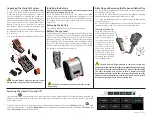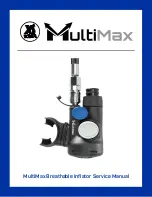
Model No. PS-2148
Background
3
®
Theory of Operation
Consider a blackbody of temperature
T
s
, whose shape can be
approximated as an infinite plane, and a flat detector surface parallel to
source with area
A
d
.
Because radiation from an infinite plane propagates as a plane wave,
the power flow from the source to the detector (
P
sd
) equals the radiation
emitted by a part of the source whose area is equal to the detector’s
area, regardless of the distance between the source and detector.
P
sd
=
A
d
σ
T
s
4
The detector itself also radiates in accordance to the Stefan-Boltzmann
law. If the detector’s temperature is
T
d
, then power radiating out of the
detector is
P
d
=
A
d
σ
T
d
4
Therefore, the
net
power absorbed by the detector is
P
=
A
d
σ
(
T
s
4
−
T
d
4
)
The net intensity, which is what the sensor measures, is the net power
divided by the detector area.
The net power that flows onto the active detector area by radiation
(
P
sd
−
P
d
) flows out of the detector by conduction to other parts of the
sensor. A proportion of that power is conducted through the thermopile,
which sets up a temperature different (
∆
T
) across the thermopile. The
thermopile produces a voltage (
V
) that is proportional to
∆
T
.
If the sensor is warmer than the target source, then net power flows out
of the sensor, and
∆
T
and
V
are negative.
The net radiated power (
P
) is proportional the power flow through the
thermopile, which is proportional to
∆
T
, which, in turn, is proportional
to
V
; therefore,
V
is proportional to
P
:
V
=
R
P
The constant,
R
, is known as the responsivity of the detector. For the
PS-2148 sensor,
R
is about 31 V/W.
The sensor amplifies the voltage produced by the thermopile and
converts it into a digital signal. A microprocessor in the sensor
calculates intensity, which is incident power divided by the area of the
detector (2.25 mm
2
). The thermopile voltage and intensity data are sent
digitally to the PASPORT interface or computer.
Pair of
Thermocouples
Thermopile
Cold
Hot
T
D
V
Cold
Hot
V
T
D
T
s
V
Thermopile
T
d
Source
P
sd
P
d
D
T
What is a thermopile?
A thermopile is a series
of thermocouples
A thermocouple is the
junction of two different
metals. When two
thermocouples are
connected in series, and
are at different
temperatures, a voltage
proportional to the
temperature difference
occurs between them.
This voltage is usually
very small. In a
thermopile many
thermocouples are
connected in series (as
shown below) to produce
a larger voltage. The
thermopile in the
PS-2148 consists of 120
junctions etched in
silicon.
Summary of Contents for PASPORT PS-2148
Page 10: ......




























